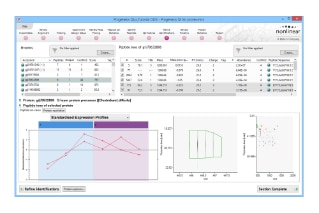Progenesis QI for Proteomics
Discover the changing proteins in your samples
Quantify and identify proteins in your complex samples using the advantages of label-free analysis with Progenesis QI for proteomics. With a highly visual guided workflow, Progenesis QI for proteomics from Waters and Nonlinear Dynamics enables you to rapidly, objectively, and reliably discover proteins of interest from single or fractionated samples using multi-group experimental designs.
Along with conventional data-dependent analysis (DDA), Progenesis QI for proteomics also supports Waters MSE and HDMSE data-independent acquisition (DIA) data analysis. Uniquely, the software also takes advantage of the additional dimension of resolution offered by ion mobility separations to improve accuracy and precision of identification and quantification. Progenesis QI for proteomics is instrument platform independent, with support for universal formats such as .mzML and .mzXML.
Overview
- Evaluate the quality of your LC-MS data with quality control (QC) metrics
- Attain consistent peak picking across all runs, vital for accurate and precise quantification, using our unique approach to co-detection of peptide ions
- Use 1D- and 2D-LC with no restrictions on the number of groups, samples, and experimental designs you can compare within your analysis
- Achieve reliable multivariate statistics with a complete data matrix and no missing values
- Query databases using common search engines to automatically combine identifications from both peptide and peptide ion quantification data
- Achieve three dimensions of resolution with full ion mobility compatibility
- Work with powerful data visualization and guided workflow for DDA and data-independent acquisition (DIA) analyses, including SONAR acquisition mode
- Aid biological understanding of discoveries with easy export to Pathway Analysis tools
Recommended Use: For quantifying and identifying proteins of interest in complex samples using label-free analysis.
Features Header
Get more done with label-free analysis
Label-free LC‑MS analysis provides users with a wide range of benefits when compared to labeled techniques, including:
- Reduced protein loading
- No labelling reagent costs
- Reduced fractionation and sample handling
- Increased sequence coverage per protein
- Increased overall proteome coverage
- Ability to compare more conditions within one experiment
Maintain statistical power in your analysis without data sacrifice
The quantify-then-identify approach taken by Progenesis QI for proteomics enables you to automatically align the features in each sample and create an in-silico aggregate map containing every peptide in the complete sample set. This aggregate map is used to consistently detect and quantify features across all samples and create a data matrix with no missing values, irrespective of the number of samples or replicates, enabling statistical power maintenance in the analysis without sacrificing potentially important data or the need for imputation.
Evaluate the quality of LC-MS input data with QC metrics
QC metric tools aim to prevent you from wasting valuable time performing analysis on sub-optimal LC-MS data, and include readouts such as LC peak width, feature dynamic range, precursor mass error, missed cleavage count, and peptide per protein count. Additionally, these QC metric tools can also be used to guide process optimization and troubleshooting.
Reliable quantification based on unique peptides and ion abundance
Progenesis QI for proteomics quantifies peptides based on ion abundance and offers the facility to utilize a spiked internal standard and user selectable "HiN" metrics to estimate absolute abundance.
The Progenesis QI for proteomics also automatically combines peptide ion quantification and identification from search results and if desired, allows the quantification of proteins based only on unique peptides.
Protein identification using multiple database search engines
Progenesis QI for proteomics is highly flexible in that it can be used to search both DIA and DDA data using a variety of user-selectable search engines. Data from multiple searches can also be combined in a single experiment. Additionally, if required, the software can be supplied with ProteinLynx Global Server (PLGS) facilitating the analysis of Waters MSE, HDMSE, DDA, and HD-DDA data.
Guided data-processing workflow
The menu-guided workflow in Progenesis QI for proteomics helps to guide you through the experimental steps in the software. If required, automation routines allow you to seamlessly move through multiple stages to maximize opportunities for unsupervised overnight and weekend data processing.
- Data import
- Automatic reference run selection and alignment
- Automatic peak picking and normalization
- Automatic protein quantification
- Protein database search
Understand protein differences with Pathway Analysis
How do we understand the protein differences in our experiments? One option is to use Pathway Analysis, which determines which biological pathways are implicated in the data and thus provides the next level of information for biological contextualization. The more efficient method is to use Progenesis QI for proteomics, which features export tools that easily and quickly interface with third-party Pathway Analysis programs, efficiently identifying the protein differences in experiments.
